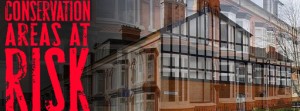Conservation Areas at Risk – an English Heritage Survey
Do you live in a conservation which you think is at risk? Have you had experience of regulations protecting conservation areas being eroded?
English Heritage is approaching every local authority in the country for a first national survey of Conservation Areas as a means of identifying those at risk. Recently Birmingham City Council said it could not longer full protect the Ideal Village Conservation Area in Bordesley Green (pdf map), which had an article 4(2) protection, because of the extent of breaches of conditions there. (See the Birmingham Post report here.)
EH wonders if you too are worried about a proliferation of plastic windows or oversized extensions, if so you can sign up to keep track of it’s campaign by signing up here. The English Heritage news release tells us:
“England has some 9,300 Conservation Areas, historic parts of cities, towns, suburbs and villages designated by local authorities to protect their special character. But what condition are they in? Are they cherished through a close partnership of council and residents? Or are they at risk from neglect, decay and inappropriate development?
Conservation Areas vary enormously. They include, for example, the Belgravia Conservation Area in central London, the industrial heritage of Birmingham’s Jewellery Quarter, the fishing village of Clovelly in North Devon and the Victorian People’s Park Conservation Area in Halifax. The heart of a historic town might be a Conservation Area. So too might be a street of well-preserved 1930s semi-detached houses or an isolated group of farm buildings. Details of local Conservation Areas are held by councils and can usually be found on their websites.
English Heritage has asked every Local Authority in the country to fill in a questionnaire for each of their Conservation Areas as part of the first nationwide census of the condition of this important element of our heritage. The results will be announced and a campaign will be launched on 23rd June to help councils, communities and individual residents to care for these special places.”
Birmingham’s first conservation areas were created in 1969 in Harborne, Yardley, Edgbaston, Kings Norton and Northfield. You can find a full list of all 27 areas in Birmingham here:
www.birmingham.gov.uk/conservationareas.bcc
If you have any comments on conservation areas please leave them below.
For other’s blogging about conservation areas in the UK see also:
Kingsdown Conservation Group (also in Bristol)



